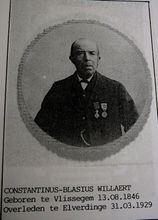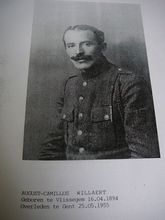Family tree Jacobs » Nn Willaert (1920)
Personal data Nn Willaert
- He was born (stillborn) on January 18, 1920 (stillborn) in Klemskerke.
- He died on January 18, 1920 in Klemskerke.
- A child of Augustus Camillus Willaert and Laura Irma Vandaele
- This information was last updated on August 15, 2007.
Household of Nn Willaert
Timeline Nn Willaert
This functionality is only available in Javascript supporting browsers.
Click on the names for more info.
Symbols used:  grandparents
grandparents
 parents
parents
 brothers/sisters
brothers/sisters
 children
children
 grandparents
grandparents
 parents
parents
 brothers/sisters
brothers/sisters
 children
children
Ancestors (and descendant) of Nn Willaert
Stillborn child Nn Willaert | ||||||||||||||||||
The data shown has no sources.
Matches in other publications
This person also appears in the publication:Historical events
Birthday January 18, 1920
- The temperature on January 18, 1920 was between 8.3 °C and 9.4 °C and averaged 9.0 °C. There was 0.6 mm of rain. The average windspeed was 4 Bft (moderate breeze) and was prevailing from the west-southwest. Source: KNMI
- Koningin Wilhelmina (Huis van Oranje-Nassau) was from 1890 till 1948 sovereign of the Netherlands (also known as Koninkrijk der Nederlanden)
- In The Netherlands , there was from September 9, 1918 to September 18, 1922 the cabinet Ruys de Beerenbrouck I, with Jonkheer mr. Ch.J.M. Ruys de Beerenbrouck (RKSP) as prime minister.
- In the year 1920: Source: Wikipedia
- The Netherlands had about 6.8 million citizens.
- January 10 » League of Nations Covenant enters into force. On January 16 the organization holds its first council meeting, in Paris.
- February 10 » About 75% of the population in Zone I votes to join Denmark in the 1920 Schleswig plebiscites.
- March 14 » In the second of the 1920 Schleswig plebiscites, about 80% of the population in Zone II votes to remain part of Weimar Germany.
- March 22 » Azeri and Turkish army soldiers with participation of Kurdish gangs attacked the Armenian inhabitants of Shushi (Nagorno Karabakh).
- December 11 » Irish War of Independence: In retaliation for a recent IRA ambush, British forces burn and loot numerous buildings in Cork city. Many civilians report being beaten, shot at, robbed and verbally abused by British forces.
- December 22 » The GOELRO economic development plan is adopted by the 8th Congress of Soviets of the Russian SFSR.
Same birth/death day
- 1917 » Nicholas Oresko, American sergeant, Medal of Honor recipient († 2013)
- 1917 » Wang Yung-ching, Taiwanese-American businessman († 2008)
- 1918 » Gustave Gingras, Canadian-English physician and educator († 1996)
- 1919 » Toni Turek, German footballer († 1984)
- 1921 » Yoichiro Nambu, Japanese-American physicist and academic, Nobel Prize laureate († 2015)
- 1923 » John Graham, General Officer Commanding (GOC) Wales († 2012)
About the surname Willaert
- View the information that Genealogie Online has about the surname Willaert.
- Check the information Open Archives has about Willaert.
- Check the Wie (onder)zoekt wie? register to see who is (re)searching Willaert.
The Family tree Jacobs publication was prepared by Michael Jacobs.
When copying data from this family tree, please include a reference to the origin:
Michael Jacobs, "Family tree Jacobs", database, Genealogy Online (https://www.genealogieonline.nl/stamboom-michael-jacobs/I64101.php : accessed April 30, 2025), "Nn Willaert (1920)".
Michael Jacobs, "Family tree Jacobs", database, Genealogy Online (https://www.genealogieonline.nl/stamboom-michael-jacobs/I64101.php : accessed April 30, 2025), "Nn Willaert (1920)".

